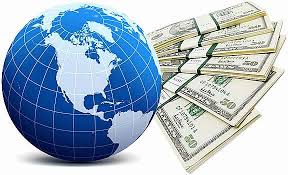Global Rising Rates Repercussions
China's central bank raised lending rates last Thursday for the first time in a year and a half. This was obviously to rein in the world's fastest-growing economy. The action may not be so important if the US did not also do the same. The Fed appears to imply that there might be further increases in US rates. The Chinese action aims to slow a spectacular surge in investment and it may potentially brake China's voracious appetite on world markets for oil and other commodities. With interest rates already climbing in the United States and the EU, and with monetary officials starting to tighten policy in Japan, China seems to be joining the world's central bankers in trying to gain control of speculation that has driven up prices of assets like gold and real estate. From steel mills and auto factories to luxury apartment buildings and plush office complexes, China has been engaged in a nationwide building boom fueled by easy loans from banks and other financial institutions. New loans soared at least 61% in the first quarter of this year compared with the period last year, causing investment in factories and other fixed assets to climb 29.8%.
China's boom in lending and investment, which has contributed to the country's rapidly rising exports, pushed growth in China's economy to 10.2% in the first quarter. That was high even by China's extraordinary standards, and so strong that President Hu himself warned on April 16 that the country needed efficient, high-quality development and not "excessively rapid economic growth." Prime Minister Wen Jiabao warned on April 14 that China would move to tighten controls on real estate and lending.
One can understand why China needed to raise rates, however that is in an environment where its currency is also appreciating. The rates squeezing movement in the US and EU have also forced second tiered players such as the smaller Asian economies to follow suit. Now we have a situation where most country's stockmarkets, interest rates and currency are on an uptrend. The exception being US where their currency would come under more pressure. Usually higher rates would stifle equity markets but that equation seems to be ineffective for the time being. All that is more surprising in that oil prices are also stubbornly high. Not to mention other commodities, including gold.
Long term observers of gold would note that gold rallies tend to coincide with long periods where returns from other asset class are diminished. Again, that does not seem to apply for now.
Growth in equity markets will be pared down by higher rates but investors are attracted to potential gains in the respective country's currencies also. So what gives?
These are the important conclusions:
1) US is printing a whole bucket loads of money. In order to finance the consumption patterns in America, US dollars in circulation has to rise. As long as there are willing holders of US Treasuries, nothing really bad will happen.
2) More funds chasing after assets of all classes. The result of that is higher demand for all commodities (limited supply) thus pushing prices higher. Hence we can argue that all asset classes are not really rising in real productivity value but due to higher dollarisation. To that end, timber and palm oil prices should have a lot more room to rise in the forseeable future.
3) Investors are still pouring funds into stocks of almost all markets, chasing equity and currency gains at the expenses of US dollar. They will continue to do that until the US dollar drops substantially, thus improving actual returns of investors (hedge funds included).
4) Rates cannot continue to rise without something happening to asset prices. Already equity markets in China are one of the worst performers in 1Q06. Surprisingly, equity prices in America have surged. The inevitable will happen, there will be more rate hikes in the US and the bottom will fall out.
5) While I have argued before in my blog on the resilience of the US dollar, it appears that the moon and stars have converged to force the issue. If the Fed tries to delay the substantial correction in US dollar, they will have no choice but to put in further increases in rates. The next rate increase may still not be sufficient to derail the status quo. I figure a total of 150 basis points increase from now should do it. Roughly 3 times of 50 basis points increase.
6) What China is doing in raising rates is more to protect its domestic overheated economy. Plus China will allow for the yuan to appreciate gradually. Both will put a stifling effect on Chinese stocks this year.
7) As for smaller emerging and developing markets such as Singapore, Malaysia, Thailand, Indonesia, HK - they will be forced to follow suit on any US/China rate increases. However, their stockmarkets would have a better chance of rising further after having recovered from 97/98 financial implosion. A substantial correction in US dollar would spell a temporary end to their bull runs as investors would then be able to lock up gains and cash out.
Is there any way the US dollar could afford to stave off the devaluation? Not this time as every single asset class seems to be ganging up to push the dollar lower. How many more rate increases can the Fed make to support the dollar without derailing the US domestic economy?
Oil prices can stay high while rates rise and equity prices rise because real demand generally comes from real productivity demand. Even if you pay a higher price for a commodity, it still works because the product used generates sufficient improvement in productivity in countries like China and India. Consuming nations like the US and Japan will have to bear the burden as that will eat into margins without sufficient improvements in productivity. For Japan, the case is slightly different because it is finally emerging from its deep recession of over 13 years. Hence the economy can withstand much more rate increases from a very low base.
What is a sufficient devaluation of US dollar? Probably at least 15%-20% from current values.
Chinese officials were probably not worried about inflation, given that the consumer price index in China was just eight-tenths of a percent higher in March than a year earlier. That is a luxury the Fed does not have in the US. While the smaller Asian nations would be able to better cope with inflation via their appreciating currency.
skip to main |
skip to sidebar















tips, tricks, business, news, information, services, business, SEO, internet, websites, blogs, business, news, health, facebook, twitter, automotive, online marketing, unique, funny, zodiac, sport
Blog Archive
-
▼
2006
(308)
-
▼
April
(28)
- Global Rising Rates RepercussionsChina's central b...
- HK's Missing Legacy Part Deux
- AirAsia & Tenaga Covered WarrantsFairly Valued?Cov...
- The Next Big Thing For Asian Exchanges (ex-Japan)E...
- Companies That Are Truly GlobalIn an article by Go...
- The Devil Does Not Wear PradaDa Vinci Code Reloade...
- Still Got Them Cowboys In West AustraliaOld Boys' ...
- Danger Ahead, China Real EstateProperty prices in ...
- Onerous Sarbanes-Oxley To Allow ExemptionsFollowin...
- Short Sellers Get Short StrawedThe Ugly Child Only...
- Single Stock Futures - Great IntroductionThis is e...
- A Shift To Small CapsIf we look at the senior empl...
- Calpers / Wilshire Associates
- China Construction Bank Eyeing Bear StearnsAfter L...
- Pirated DVDs/VCDs Tycoons' Operations
- The New Corporate RaidersThe Burger King StoryBack...
- Malaysia-Singapore TiesBrawling Teenage Kids That ...
- Reiterating A Bullish Year For Asian Stocks
- Sarbanes-Oxley/Nasdaq/LSE
- Possibly The World's Most Valuable Unlisted Website
- Highly Speculative Stocks On KLSE NowTheir Danger ...
- Global Economics - Generalisations & Hidden Truths
- The Parable Of Paternalism
- No More Silly Records Breaking Please!
- Weekly Snippets, Snipes & SnidesApril 1 - April 6,...
- The Signs Are There For Shanghai
- Thaksin's Smartest MoveHow To Win, Then Concede, T...
- Weekly Snippets, Snipes & SnidesMarch 27 - April 1...
-
▼
April
(28)
Total Pageviews
232,705
No comments:
Post a Comment